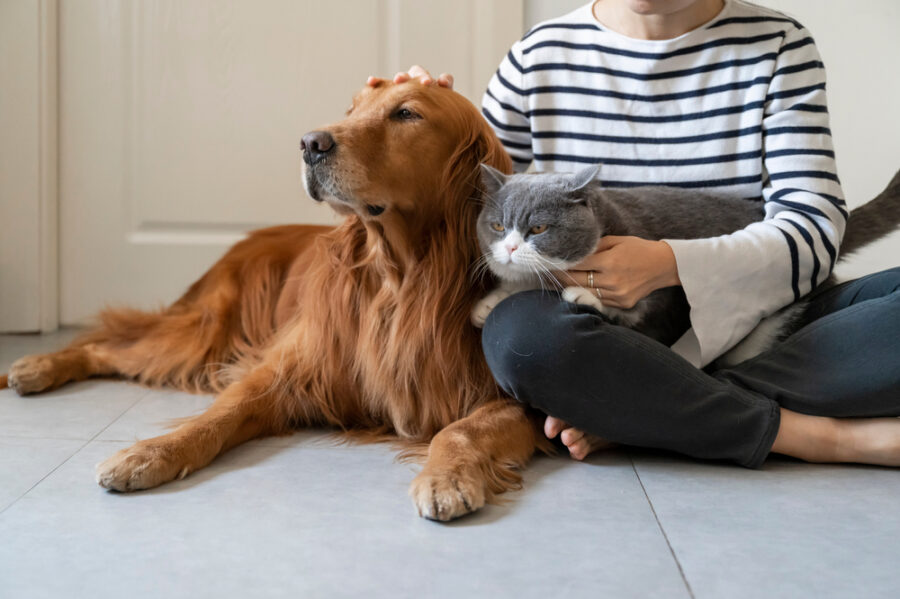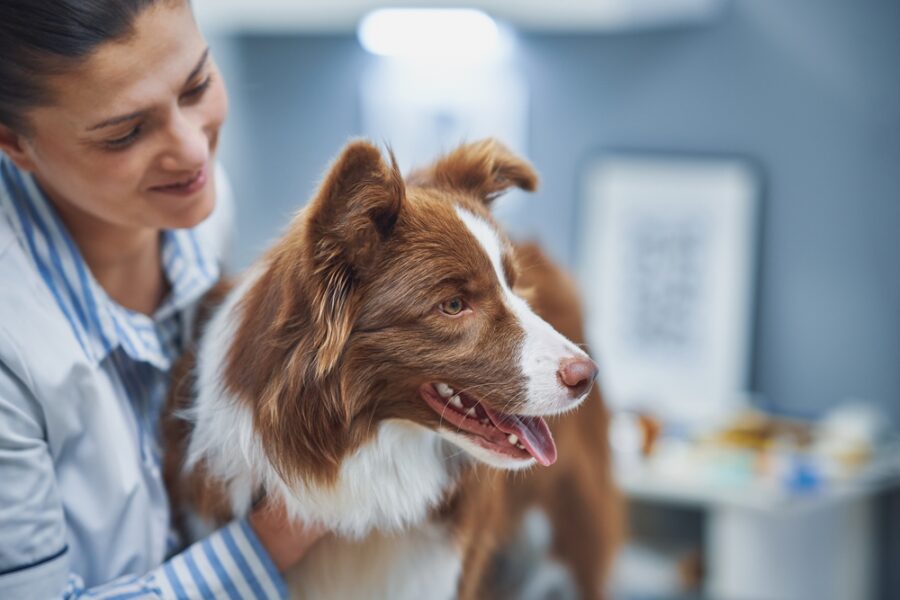Toxin ingestion among pets is a common problem and can quickly become a life-threatening situation. Saving lives relies on prompt action both at home and in the veterinary clinic setting.
The homes of our veterinary clients contain many potential toxins. On an almost daily basis, I seem to be responding to questions about the safety of various foods, drugs, cleaning products, and plants. In this article, I will highlight the most common household items that are toxic to dogs and cats, then cover recommendations for treatment and prevention.
EMERGENCY AT-HOME INSTRUCTIONS
With any potential toxin ingestion, time is critical. If the owner notices the patient eating the offending item, and has the wherewithal to call the veterinary hospital, we can help in a few ways.
First, we can determine if toxicity has actually occurred. Some ingestions are non-toxic because the patient is large; for example, a Great Dane eating one Hersheys Kiss. But other ingestions are immediate emergency situations, such as a Chihuahua eating a container of gum containing xylitol. In the latter situation, if the owner can induce vomiting right away, it would mean the difference between life and death for the dog, since xylitol can dangerously lower blood glucose in 30 minutes.
For dogs, we can aid clients by walking them through how to induce vomiting at home. They can dose the dog with 3% hydrogen peroxide at 1 teaspoon per 5 pounds of body weight. If the client doesnt have 3% hydrogen peroxide, they can make a strong salt solution by mixing 4 tablespoons of table salt in an 8-ounce glass of water. If the pet has not eaten within two hours of ingesting the poison, a small meal before inducing vomiting may help bring up the toxin.
Inducing vomiting in the above manner can take up to 20 minutes for results. I usually recommend that clients repeat the dose if the dog has not vomited in that time. If this fails, they must bring the dog into the veterinary hospital, or go to the nearest emergency facility if after hours. If the induction is successful, the dog may be nauseated for another 45 minutes.
It is only appropriate to recommend the induction of vomiting if the patient is not already throwing up; is not too lethargic to swallow; or has not eaten anything corrosive or sharp. If there is any doubt, it is best to recommend the client bring the animal into the hospital for imaging or professional emesis induction.
PEROXIDE AND SALT NOT SAFE FOR CAT
When inducing vomiting in a poisoned animal, its important to keep in mind that peroxide and salt arent safe for cats. The risk for gastric lining sloughing and hypernatremia from salt is too great. If inducing emesis is indicated in a cat, it is best done at the veterinary clinic.
TREATING A POISONED PET IN THE CLINIC SETTING
Unfortunately, in many cases, the owners are not home at the time the toxin exposure occurs. Others may fail to understand the gravity of the situation. When a patient is presented at the veterinary hospital for a toxin exposure, the critical information we need to get from the client is type of toxin, quantity, and when the ingestion occurred. Ideally, asking the owner to bring in product packaging can save a lot of time and confusion. This is particularly important in the case of rodenticides, since bromethalin works very differently from anti-coagulant types. If a pet has grabbed a dropped prescription drug, ask the owner to bring in the bottle. If they do not know which pill they dropped, ask them to bring them all. The more data you have at the beginning of the case, the better you will be able to manage the patient.
1. If a short length of time has elapsed after the ingestion, we can induce emesis in a few different ways.
A. My favorite for dogs is IV apomorphine. I use the VIN Veterinary Drug handbook to determine dosing, utilizing 0.05mg/kg IV. I find this works quickly, and typically see results in less than five minutes.
B. For cats, we use dexmedetomidine, 8ug/kg intramuscularly, according to the VIN boards.
C. Orally administering activated charcoal post emesis can help prevent further absorption of the ingested toxin. It is important to control vomiting before giving charcoal, since the risk of aspiration is high if the animal is still nauseated. Be careful to give the one recommended dose of 1-4g/kg. Overdosing, or repeated dosing more than every eight to 12 hours, can cause hypernatremia.
2. Once a toxin has been absorbed by the animals body, we must determine which systems will be affected by that food, drug, or plant. Typically, we see gastrointestinal signs, hepatic damage, renal damage, CNS signs and cardiac and circulatory collapse.
A. A complete blood count, chemistry panel, electrolytes and urinalysis are basic values needed to properly address the patients situation.
B. Imaging can be helpful, as can FAST ultrasound to determine if a GI perforation has occurred.
C. IV fluid therapy is necessary to flush the toxin from the patients system as well as support them through the effects of the poison. Good fluid choices include Normosol-R, LRS and Plasmalyte-148 for the dehydrated patient. Fluid selection should be based on the blood work, paying particular attention to sodium levels. Fluid rates depend on the level of dehydration. If you multiply the percentage of dehydration times the patients body weight in kilograms, you determine the liters of fluid they need to correct the dehydration.
If the patient is severely dehydrated, quickly replacing the fluids is indicated. I will usually double the maintenance rates until the patient is rehydrated. According to the AAHA, fluid maintenance rates for cats are 2-3ml/kg per hour; for dogs, theyre 2-6ml/kg per hour. Monitoring hydration through serial urine concentration and volume assessments is vital to adjusting fluid therapy as needed. Checking chemistry panels every other day is also wise.
Once you have established an IV treatment plan, the next order of business is to determine the medications needed to support the patients recovery. Gastro-protectants such as misoprostol at 2-5mcg/kg IV every eight hours, or famotidine at 0.5-1mg/kg IV every eight to 12 hours will help prevent gastric ulceration in the event of NSAID overdose. Oral sucralfate at 0.5-1g every eight to 12 hours is wonderful once the patient has stopped vomiting. Other oral medications must be given at least one hour after sucralfate due to its superior gastric coating action. Oral famotidine at 0.5-1mg/kg every 12 hours is indicated for up to a week post hospitalization.
Treatment to control seizures in patients with chocolate toxicity are as follows: IV diazepam at 0.5-1mg/kg or intra-rectal diazepam at 0.5mg/kg. Midazolam may also be used IV at 0.5-1mg/kg or 0.2mg/kg intranasally. If diazepam and midazolam fail, then try IV propofol slowly until the seizures stop, then as a continuous rate infusion (CRI) of 0.1-0.6mg/kg/min. Slowly lower the rate until the patient resumes consciousness.
Treatment duration depends on the type and quantity of the toxin the animal ingested. Some patients require weeklong intensive care, while some can be discharged after emesis induction. Once the animal has produced the concerning item, I will give them Cerenia (maropitant) at 1mg/kg. This will stop the vomiting and make for a happier client with a clean car.
TOP 10 POISONS
The following list is a combination of the top ten poisons for 2022, as compiled by the ASPCA Animal Poison Control and the Pet Poison Helpline.
- OTC human medications: Advil, Tylenol, vitamin D3
- Human foods: grapes, raisins, onion, xylitol-containing gum/candy, protein bars and other snack bars
- Prescription human medications: antidepressants, anticonvulsants and cardiac drugs were most common
- Chocolate
- Plants/flowers: lilies, philodendron, etc.
- Cleaning products: bleach, sticky products
- Veterinary products: carprofen, other chewable drugs
- Rodenticides: bromethalin and anti-coagulant types
- Insecticides: ant traps, fly tape
- Marijuana
As always, prevention is our main goal when it comes to poisoning! To assist you and your clients, I have developed an app called VetProtect (available through Android and Apple) that lists a wide variety of human foods and drugs, and whether or not they are toxic.








